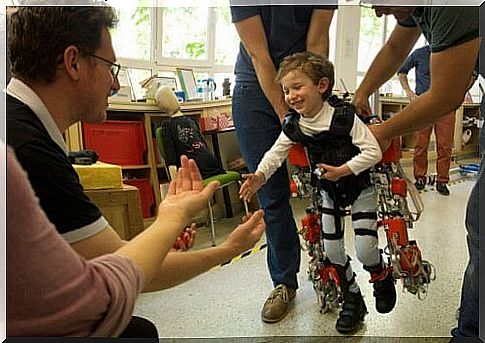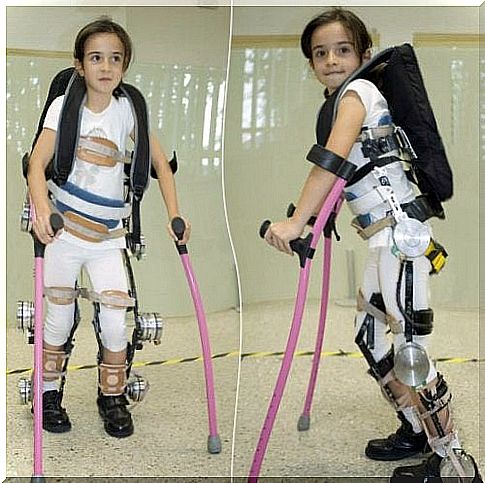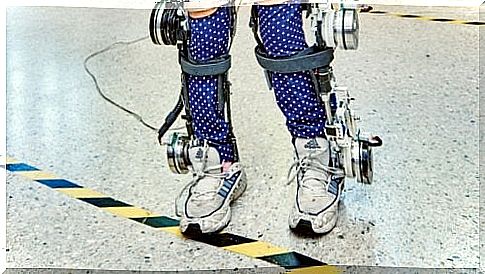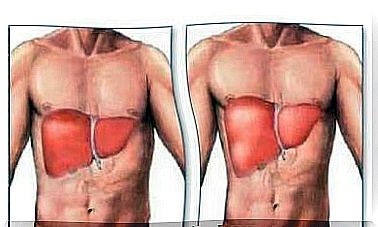An Exoskeleton Was Created For Paraplegic Children

Many scientists are making efforts so that, in a few years, no one will have to use a wheelchair. We are not referring to scientific advances or medical discoveries regarding the reconstruction of the spine. We are talking about neuroscience and robotics, two fields that merge in order to produce extraordinary devices, such as this exoskeleton for paraplegic children.
In the near future, those working in technology and engineering will connect their world, full of chips, cables and sensors to our bodies. In this way, partially or totally damaged parts of the body will function again. This field of development offers hope to a multitude of people, which is why it needs support and funding from the institutions.
One of the most promising projects is, without a doubt, an exoskeleton for paraplegic children, which could help them walk again. It is an emotional and complex topic that we want to discuss in the lines below.
More than movement: an exoskeleton for paraplegic children
This mechanical exoskeleton uses engineering studied and developed for some time in several fields, such as military and medical. It is based on various biometric sensors, batteries and hydraulic motors.
At first glance, the device seems ostentatious and even cumbersome, but the idea is to get the most ergonomic equipment. Thus, the exoskeleton can improve the lives of people with reduced mobility and restore their freedom.
Paraplegic children: the patients who need this technology the most
A well-known exoskeleton is the 2005 HAL-5 model, designed to help the elderly or people with disabilities walk. This device has a durable battery, does not weigh much and has a pleasant appearance.
Even though there is one for the elderly, the specialists also created an exoskeleton for children, which was presented in June this year. Although the product is still in the experimental phase, the Spanish National Research Council (CSIC) claims that this is just the beginning of the road in terms of this technology.
- It is vital to be able to provide an exoskeleton for paraplegic children aged 3 to 14 who suffer from spinal problems.
The project leaders claim that, soon, this exoskeleton will be available in hospitals, being used as a method of muscle therapy. The training will help children with spinal amyotrophy to maintain their mobility.

- An intense recovery program with this exoskeleton is vital for children. Due to their neuroplasticity and their ability to partially regain their mobility, children have higher hopes of recovery than adults.
- This exoskeleton for paraplegic children is especially needed in cases of muscle atrophy. This disease is diagnosed in babies aged 7 to 14 months. Therefore, these children have not taken a single step in their entire lives. In addition, their physical and muscular damage is generally progressive.
- Offering the exoskeleton to small patients with muscle atrophy is a ray of hope for both children and their families.
The device can give the little ones a better life. In addition to improving mobility, the exoskeleton also provides them with better physical health, reducing the possibility of worsening the condition they suffer from.
The exoskeleton has an uncertain future
This exoskeleton for paraplegic children is like the armor of the Iron Man. The device helps the little ones to stand up and do something that many of them have never done before: to walk.
- The exoskeleton works on the basis of a system that stimulates the spine through sensors. The provoked neural response, no matter how weak, activates the exoskeleton.
- The problem is that every child has a different type of muscle atrophy or spinal condition. Thus, in order for all patients to receive the optimal treatment, a personalized exoskeleton must be built for each one.
- In addition, exoskeletons are complex and expensive. Although it is a huge hope for children and their relatives, few would afford to buy them.
- There are only a few models in some hospitals. At the same time, the project leaders claim that the only way children can benefit from such a device is to rent it. Unfortunately, this service would cost more than € 800 per month.

This figure is quite high for most families. Therefore, purchasing an exoskeleton for their child is an impossible dream for many parents. Thus, the news of the invention of this device becomes a reason for sadness rather than joy.
Children should use the exoskeleton from now on. Every passing month is a waste of time for recovery. Waiting also reduces a child’s chances of improving their quality of life.
We hope that government institutions will invest in such projects, because something as simple and wonderful as the ability to walk should be accessible to anyone.









